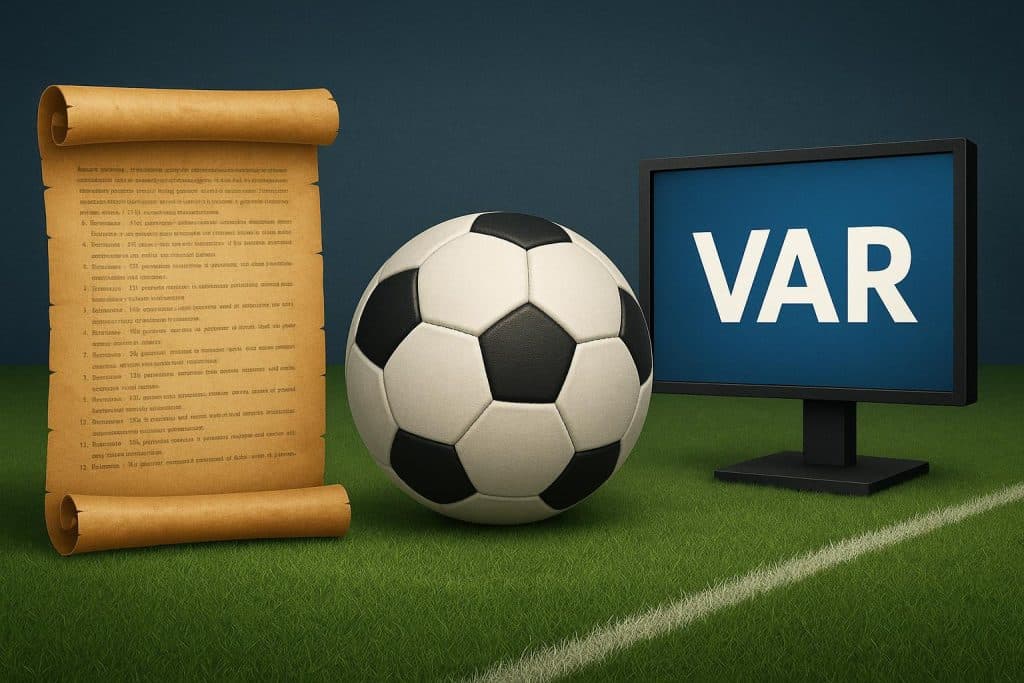Football did not become “the beautiful game” by chance: its popularity is the result of a series of turning points – regulatory, technological, organizational and media-related – that enhanced its spectacle, fairness and recognizability. From the 19th-century codification to the era of sensors and video replays, here are the innovations that most transformed the game and built its global fame.
The birth of common rules and the single referee
In 1863, the Football Association was founded in London: it was the first shared code that definitively separated football from rugby and started a process of rule standardization. In 1886, the British federations created the IFAB, custodian of the “Laws of the Game,” later joined by FIFA and still the sole body that governs rule changes today. Standardization (90 minutes, 11 v 11, etc.) made the game recognizable everywhere, creating the foundation for global diffusion.
Offside: two defenders (1925) and “level is onside” (1990)
Few adjustments shaped the game like offside. In 1925, the IFAB reduced the requirement from three defenders between attacker and goal to two: the field “stretched,” new tactics such as the W-M emerged, and goal chances increased. In 1990 another offensive boost came: an attacker level with the penultimate defender was no longer offside. Two tweaks that made the game faster and more spectacular.
Yellow/red cards (1970) and penalty shootouts
To improve clarity and discipline, yellow and red cards – invented by Ken Aston – debuted at the 1970 World Cup: a universal language that helped referees, players and audiences alike. In the same year, the IFAB introduced penalty shootouts as the official method to decide tied matches, reducing endless replays and fixture congestion.
Back-pass ban, 3 points for a win and other incentives for attacking football (1980s–1990s)
After the slow and overly defensive 1990 World Cup, the IFAB banned in 1992 the goalkeeper from handling deliberate back-passes: pressing became vital and keepers had to play with their feet. At the same time, the three-points-for-a-win system (first tested in England in 1981, later adopted worldwide) and stricter time-wasting rules increased tempo and intensity. These combined measures reshaped the rhythm of modern football.
From “necessity” substitutions to player protection
Substitutions, initially limited and introduced in 1958, evolved until the recent turning point: five changes permanently allowed from 2022 to safeguard player health in overcrowded schedules. In 2024, permanent additional substitutions for suspected concussions entered the Laws (optional for competitions), alongside continued trials of temporary “sin bins” to improve player behavior and time management.
The media revolution: Premier League, Champions League and the “football product”
In 1992, the Premier League was born with a new commercial model built on centralized TV rights: the deal with Sky forever changed the relationship between football and broadcasting, multiplying revenues and audiences worldwide. Around the same time, the European Cup became the UEFA Champions League, with branding, anthem and group stage format that turned it into a global show. From 2024/25, the “Swiss model” reform further expands matches and audiences. Together with the exponential growth of the World Cup’s reach, these changes built football’s international fame.
On-field technologies: Goal-Line, VAR and semi-automated offside
After decades of debate, the IFAB approved Goal-Line Technology in 2012: by the 2014 World Cup, referees received a vibration on their watch to decide goal/no goal. In 2018, the VAR entered the Laws: video supports referees on goals, penalties, straight reds and mistaken identity, while the final word remains on the pitch. In 2022, FIFA introduced Semi-Automated Offside Technology (SAOT) at the World Cup, speeding up and objectifying offside checks through 3D body tracking and a connected ball.
The Bosman ruling and the globalization of talent
The 1995 Bosman ruling by the European Court of Justice abolished transfer restrictions at the end of contracts and nationality quotas for EU players, liberalizing the labor market. Its consequences – player mobility, internationalized squads, new power balances between clubs and athletes – reshaped the economics of European football and, indirectly, amplified its global appeal.
Data, GPS and “new lenses” to read the game
In recent years, FIFA standardized Electronic Performance & Tracking Systems (EPTS) – from wearables to optical tools – with quality programs to certify safety and performance. Alongside tracking, advanced metrics exploded: above all, Expected Goals (xG), which estimates the probability of scoring each shot, helping evaluate performance beyond the scoreline. For today’s digital audiences, data analysis – from pressure maps to predictive models – now coexists with comparators that display the best football odds as an informational indicator of sporting expectations, distinct from tactical-technical analysis.
Why these innovations truly matter
If the basic rules gave the game its identity, tweaks to offside, back-pass and points system made football more attacking. Cards and penalty shootouts increased order and finality, while technologies (Goal-Line, VAR, SAOT) enhanced perceived fairness. The commercial framework of the Premier League and Champions League, together with the freedom of movement after Bosman, created a global ecosystem that attracted investment, talent and audiences like never before. Finally, the culture of data and player welfare – from five subs to concussion protocols – shows a game that keeps evolving without betraying its essence.
